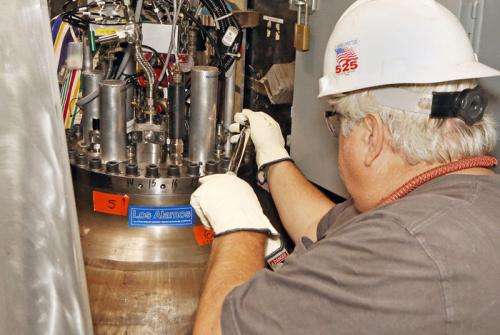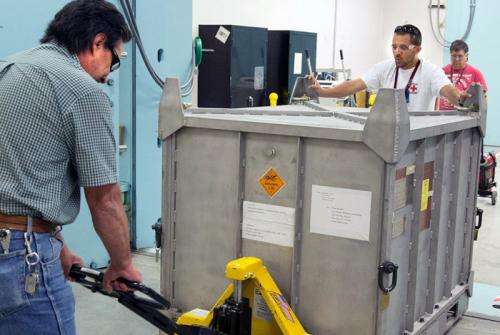Technicians at the Nevada National Security Site make final adjustments to the "Leda" experimental vessel in the "Zero Room" at the underground U1a facility.
Los Alamos National Laboratory has successfully fired the latest in a series of experiments at the Nevada National Security Site (NNSS).
"Leda is an integrated experiment that provides important surrogate hydrodynamic materials data in support of the Laboratory's stewardship of the U. S. nuclear deterrent," said Bob Webster, Associate Director for Weapons Physics.
The experiment, conducted on Aug. 12, 2014, consisted of a plutonium surrogate material and high explosives to implode a "weapon-relevant geometry," according to Webster.
Hydrodynamic experiments such as Leda involve non-nuclear surrogate materials that mimic many of the properties of nuclear materials. Hydrodynamics refers to the physics involved when solids, under extreme conditions, begin to mix and flow like liquids. Other hydrodynamic experiments conducted at NNSS use small amounts of nuclear material, and are called "sub-critical" because they do not contain enough material to cause a nuclear explosion.
"This experiment ultimately enhances confidence in our ability to predictively model and assess weapon performance in the absence of full-scale underground nuclear testing," said Webster. These experiments with surrogate materials provide a principle linkage with scaled/full-scale hydrodynamic tests, the suite of prior underground nuclear tests, and scaled plutonium experiments.
"Experiments like Leda are key to enhancing predictive confidence, challenging next-generation weapon designers, and enhancing our capability to underwrite options for managing the stockpile," said Charlie Nakhleh, Theoretical Design Division Leader.
Such hydrodynamic and sub-critical experiments are one of the most useful multi-disciplinary technical activities that exercise the Laboratory's manufacturing capabilities, tests scientific judgment, and enhances the competency of the Nevada workforce in areas of formality of underground and nuclear operations.
Immediately following the experiment, conducted at NNSS's U1a underground complex in collaboration with NSTec and supported by Sandia National Laboratories, Los Alamos scientists and technicians reported a 100 percent data return.
"Multiple diagnostics that captured the hydrodynamic and implosion processes included pit and case velocimetry, dual-axis x-ray radiography, dynamic surface imaging, optical and electrical monitors of the high-explosive drive as well as detonator performance, and very accurate overall system cross-timing," said Mark Chadwick, Program Director for Science Campaigns in the weapons physics directorate. "The experiment was operated within expected parameters, including temperature control, and was performed within the required safety and security specifications."
Technicians at the Nevada National Security Site move the experiment in a specially designed container from the Device Assembly Facility.
Scientists will now study the data in detail and compare with pre-shot predictions. The resulting findings will help assess the confidence weapon designers have in their ability to predict weapon-relevant physics.
The successful execution of the Leda experiment enables the follow-on sub-critical experiment series, nicknamed Lyra, to be conducted in 2015. Lyra and other related experiments are an essential component in the NNSA's Science Campaigns and Plutonium Sustainment Programs to support the technical basis for confidence in the nation's nuclear deterrent, and to support future stockpile stewardship.
Provided by Los Alamos National Laboratory





















